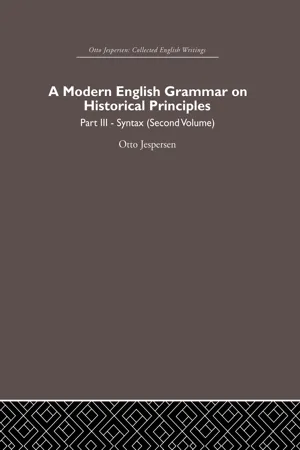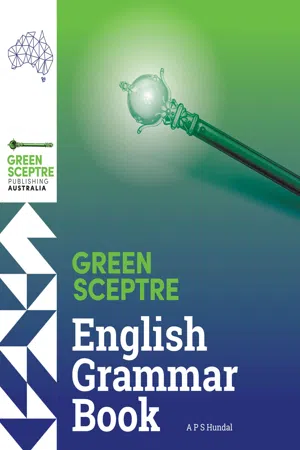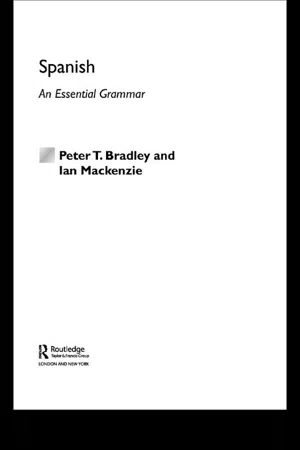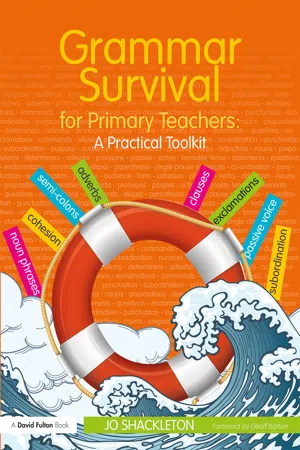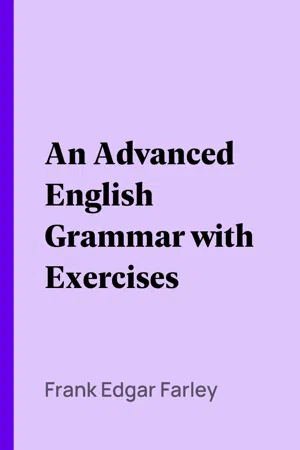Languages & Linguistics
Adjectival Clause
An adjectival clause is a group of words that functions as an adjective within a sentence. It provides additional information about a noun or pronoun. Adjectival clauses often begin with relative pronouns such as "who," "which," or "that," and they help to add descriptive details to the noun they modify.
Written by Perlego with AI-assistance
8 Key excerpts on "Adjectival Clause"
Learn about this page
Index pages curate the most relevant extracts from our library of academic textbooks. They’ve been created using an in-house natural language model (NLM), each adding context and meaning to key research topics.
- eBook - ePub
- Otto Jespersen(Author)
- 2013(Publication Date)
- Routledge(Publisher)
Chapter IV Relative Clause AdjunctsIn ordinary combinations like:4.11 .In vol. II we have seen various kinds of adjuncts: adjectives, substantives, pronouns, also word-groups like infinitives with to, etc. Here we shall deal with clauses as adjuncts. The only clauses employed thus are the so-called relative clauses, and on the other hand the chief use of relative clauses is that of serving as adjuncts, though some are used as primaries (see ch. III ) and others as subjuncts (see vol. V ch. 21).a man who knows nothing the facts we mentioned above the room where (in which ) he slept, etc. —the relative clause is an adjunct, as can often be shown by the possibility of substituting an ordinary adjective-adjunct, as an ignorant man and the above-mentioned facts for the first two examples; but this is no certain criterion, and the clause is an adjunct in those cases as well, in which no such substitution is possible, as in the third example above. The primary to which the relative clause is made an adjunct is generally called the antecedent.4.12 .It is a natural consequence of the adjunct nature of the relative clause that there is a tendency in many languages to use and before a clause if the primary has another adjunct. This is the regular idiom in French, but is generally looked upon as a fault when it occurs in English, see, for instance, Krapp, Mod. Engl. - eBook - ePub
A Sentence Diagramming Primer
The Reed & Kellogg System Step-By-Step
- Dr. Judith Coats(Author)
- 2017(Publication Date)
- Page Publishing, Inc.(Publisher)
Adjective Clause Introduced by a Relative Adverb Rather Than by a Relative Pronoun What Do You Do with an Adjective Clause Introduced by a Relative Adverb Instead of a Relative Pronoun?Grammatical explanation. Adjective clauses are usually introduced by a relative pronoun (who , whom , whose , which , and that ). However, they may also be introduced by a relative adverb (where , when , and why ). In that case, the relative adverb is introducing an adjective clause, connecting it to a noun in the sentence and retaining its adverb qualities by relating to the verb of the dependent clause. Here is an example sentence to think about: Pembine Family Restaurant is the place where we have many memories . The word where is referring back to the word place and also supporting the verb have as where we have all of the memories.Diagramming explanation. So the relative adverb would be diagrammed on both a dotted and solid line extending from the word place to the word have in the dependent Adjectival Clause. Let’s see if the example diagram clarifies the problem.Note: Where we have many memories could mistakenly be seen as an adverb clause. However, it describes the noun place rather than describes a verb. - eBook - ePub
- APS Hundal(Author)
- 2022(Publication Date)
- Green Sceptre Publishing Australia(Publisher)
It is a dependent clause that modifies noun or pronoun in the sentence. This clause begins with the words such as:• That• When• Who• Whom• Whose• Which• WhyFor instanceHence, we can say adjective clause gives more information about noun. Adverb clause It is a dependent clause that modifies (gives more information) verb in the sentence.The sports class that Sahil takes focuses on technique.Mr. Mach is the university professor who helped me in thesis.For instanceNoun clause It is a dependent clause functioning as a noun in the sentence. We can also say noun clause comes in place of noun in the sentence.She cried because her phone was stolen.Although Eliza was tired, she still finished her homework.I can’t wait for her younger brother until the snowfall.Alex washed the car until his hands get sore.(This adverb clause gives information how Alex washed)For instanceHere underlined portion is main clause that can stand-alone. But italicized portion can’t stand alone although having subject and verb. Hence, it is working as noun clause.That Canada winters are very cold is well known.I remember what teacher taught yesterday - eBook - ePub
- Peter T Bradley, Ian Mackenzie(Authors)
- 2004(Publication Date)
- Routledge(Publisher)
Relative clausesRelative clauses in English are often introduced by words like ‘who’, ‘whom’, ‘which’, ‘that’, ‘where’, ‘whose’:A relative clause plays a modifying role in a sentence. For example, the sequence ‘who complain’ in the sentence ‘They don’t like customers who complain’ is a relative clause and it qualifies the noun ‘customers’, since it specifies which type of customers are not liked.I haven’t spoken to the lady who booked the holiday. The meal that we had was delicious. The house where we used to live has been demolished. I don’t know the reason why they sold the house. He is the person whose flat we have been staying in.They live in a house that is close to the beach. I’ve got one that is broken.The clause introduced by these words is referred to as the subordinate clause, and the clause that contains the element qualified by the relative clause is called the main clause. The qualified element is known as the antecedent. For example, the noun ‘house’ and the pronoun ‘one’ are the antecedents in the following sentences:25.1 Differences between Spanish and English relative clauses
25.1.1 Omission of the relative pronoun
A relative pronoun in English is often omitted:The man we saw at the beach = The man that we saw at the is here. beach is here. In contrast, a Spanish relative pronoun can never be omitted. Therefore, the relative pronoun que, meaning ‘that’, cannot be omitted from the following sentence: El hombre que vimos en la playa está aquí - eBook - ePub
Grammar Survival for Primary Teachers
A Practical Toolkit
- Jo Shackleton(Author)
- 2017(Publication Date)
- Routledge(Publisher)
Subordination enables writers to express more complex ideas by building layers of meaning. It’s essential in most writing across all subjects.p.38 KNOWLEDGE What you need to know about relative clauses A relative clause is a type of subordinate clause that post-modifies a noun as part of an expanded noun phrase. It is introduced by a relative pronoun (who, whom, whose, which, that).• This is the book that I bought .• The train, which was crowded , pulled out of the station.• I went to see my best friend, who I had known since I was five .• My best friend, whose parents live in Scotland, has just moved to Cornwall .The relative adverbs when , where and why can also introduce a relative clause:• That was the moment when I knew I loved her.• This is the house where I grew up .• My workaholic lifestyle was the reason why she left .(You need to remember that where , when and that can also function as subordinating conjunctions to introduce a straightforward subordinate clause – be careful not to confuse these with relative clauses.)Sometimes the relative pronoun is omitted altogether: this is also referred to as a ‘zero’ relative pronoun.• This is the book I bought .• Is that the song you like ?• That was the moment I knew I loved her - eBook - ePub
- Luis H. González(Author)
- 2020(Publication Date)
- Routledge(Publisher)
with which we practice relative pronouns ) get the special attention and extra practice that they deserve. Finally, dozens of exercises (with answers provided) will help learners to distinguish nonrestrictive Adjectival Clauses from restrictive ones, choose the sentence with the relative pronoun that shows best the distinction, and put together two sentences by modifying an antecedent in the main clause with an Adjectival Clause. Section 6 suggests some implications for teaching. Section 7 offers conclusions.Note: Specialized or key terms are capitalized when introduced. They are explained or exemplified as needed.2.2. Nonrestrictive and restrictive Adjectival ClausesObserve sentences (1a,b) and (1d,e), and how the repetition of a common noun in sentences (1a,b) and (1d,e) (boyfriend and tool ) is avoided by combining (1a,b) as in (1c) and (1d,e) as in (1f). The mention of a noun a second time is avoided by replacing it with an appropriate RELATIVE PRONOUN (who and that in this case):- (1) a.My boyfriend[1] is visiting me this weekend.
- b. My boyfriend[2] is handsome.
- c. My boyfriend[1], who[2] is handosme , is visiting me this weekend.
- d. A hammer is a tool[1].
- e. A tool[2] is used to drive nails.
- f. A hammer is a tool[1] that[2] is used to drive nails .
- g. A hammer is a tool[1] used to drive nails.
The noun that is not repeated in (1c,f) is called the ANTECEDENT of an Adjectival Clause. The ANTECEDENT is the noun that an Adjectival Clause modifies. The sentences in (1a) and (1d) are called the main (or matrix) sentence. The sentences in (1b) and (1e) (when they are embedded in 1c,f) are called an Adjectival Clause because they function as an adjective that modifies the antecedent (my handsome boyfriend and a nail-driving tool ). Observe also that (1b) “stands” on its own, but (1e) seems an incomplete sentence. It is too vague, and it would imply that the only tool is a nail-driving one. Likewise, (1d) is somewhat vague and requires narrowing down to be easily interpretable. The string of words who is handsome in (1c) is called a NONRESTRICTIVE Adjectival Clause and the string that is used to drive nails in (1f) is called a RESTRICTIVE Adjectival Clause. A nonrestrictive Adjectival Clause expresses a property shared by all of the REFERENTS to which the antecedent refers. A restrictive Adjectival Clause expresses a property of PART of the REFERENTS to which the antecedent refers. REFERENT(S) is the people or thing(s) in the world to which a noun refers. If you are reading a paper version of this book, the referent for book is the object that you are reading right now. Finally, the sentence in (1f) can be “reduced” to (1g) by omitting the relative pronoun (that ) and the verb be , an omission commonly called COPULA DELETION (Cressey 1969; Luján 1980; among others). The name comes from the fact that the verb be is the prototypical copular verb in the languages of the world with copular verbs.1 - eBook - ePub
- Stephen Matthews, Virginia Yip(Authors)
- 2013(Publication Date)
- Routledge(Publisher)
Chapter 15Relative and noun-modifying clausesRelative clauses are clauses which modify a noun phrase. We define a relative clause as a clause (containing minimally a verb) which serves to specify the reference of a noun phrase. In this chapter, relative clauses are considered as part of a wider class of noun-modifying clauses, which also includes attributive clauses (15.4).In Chinese the relative clause precedes the noun it modifies. This is part of a general pattern of noun modification whereby modifying phrases precede the noun and are linked to it by the particle ge (15.2) or a demonstrative and classifier (15.3). This ordering is common in SOV languages (such as Japanese) but highly unusual in an SVO language such as Chinese.1 The placement of the relative clause before the noun has a number of implications. For example, whereas in English multiple relative clauses can follow the same noun, in Chinese it is rare for more than one clause to modify the noun, especially in spoken language. Another consequence is that relative clauses in Chinese are essentially of the restrictive type (15.1).2 There are two main types of relative clause in spoken Cantonese:- (a) [relative clause ge noun] (15.2)
- (b) [relative clause gó classifier noun] (15.3)
These two types are treated separately in the following sections, as they have different ranges of application: the ge type is preferred in formal language, whereas the classifier type (b) is more colloquial (Matthews and Yip 2001). The free relative clause as in Who dares, wins - eBook - ePub
- Frank Edgar Farley(Author)
- 2014(Publication Date)
- Perlego(Publisher)
THE MEANINGS OF SUBORDINATE CLAUSES393. Subordinate clauses may be classified not only according to their use as parts of speech, but also, in quite a different way, in accordance with their various meanings. These distinctions in idea are of capital importance for the accurate and forcible expression of thought.394. The variety of meanings which subordinate clauses may express is great, but most of these meanings come under the following heads:—(1) place or time, (2) cause, (3) concession, (4) purpose, (5) result, (6) condition, (7) comparison,43 (8) indirect discourse, (9) indirect question.The general meaning of the clause is usually indicated by the word which introduces it.I. CLAUSES OF PLACE AND TIME
395. An adjective or an adverbial clause may express place or time.I. Adjective Clauses
- The house where the robbery occurred is No. 14.
- The bridge over which we rode is in ruins.
- There is a point beyond which you cannot go.
- The day when (or on which) I was to sail arrived at last.
- The day before you came was rainy.
- His terror while it thundered was pitiable.
II. Adverbial Clauses
- Remain where I can see you.
- That belongs where you found it.
- Whithersoever I go, fear dogs my steps.
- Whenever the bell rings, you must take down the receiver.
- Esmond heard the chimes as he sat in his own chamber.
- I have lived in Cairo since my father died.
396. Adjective clauses of place and time may be introduced by relative pronouns (see examples above).Adjective and adverbial clauses of place and time may be introduced by relative adverbs. Thus,—
